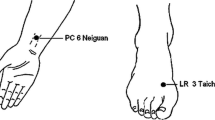Summary
Changes in the diameter of extracranial and intracranial arteries resulting in changes in cerebral blood flow have previously been assumed to be the most important pathophysiological factor in migraine. To test this hypothesis 20 normal subjects, and three groups of patients (n=29) with migraine were investigated by means of transcranial Doppler sonography. Blood flow velocities in the middle cerebral (MCA) and in basilar (BA) arteries were measured. Data from patients were obtained in the interval between migraine attacks, during migraine attacks and following treatment with either ergotamine (0.5 mg i.m.; n=10); flunarizine, a calcium overload blocker (20 mg i.v.; n=13); or a 5-HT1-like agonist (sumatriptan, 4 mg s.c.; n=6). Ergotamine and sumatriptan are constrictors of cerebral arteries in animal experiments. The arithemtic mean of flow velocity in the BA was reduced in normal subjects (45 cm/s) as compared with patients with migraine measured in between attacks (53 cm/s). Mean flow velocity in MCA was not different in normals (72.5 cm/s) as compared with migraineurs (75 cm/s). Neither ergotamine nor the 5-HT1 agonist and flunarizine resulted in a significant change in blood flow velocity in MCA and BA. This was true irrespective of whether the drugs were given in the headache-free period, during a migraine attack or during the withdrawal phase of drug-induced headache. Ergotamine was effective in improving headache during migraine attacks and sumatriptan attenuated headache during drug withdrawal from chronic analgesic intake. These results indicate that the action of ergotamine and the 5-HT1-receptor agonist is probably not mediated by their vasoconstrictor action on cerebral arteries.
Similar content being viewed by others
References
Andersen AR, Tfelt-Hansen P, Lassen NA (1987) The effect of ergotamine and dihydroergotamine or cerebral blood flow in man. Stroke 18:120–123
Apperley E, Feniuk W, Humphrey PPA, Levy GP (1980) Evidence for two types of excitatory receptor for 5-hydroxytryptamin in dog isolated vasculature. Br J Pharmacol 68:215–224
Buzzi MG, Moskowitz MA (1990) The antimigraine drug, sumatriptan (GR43175), selectively blocks neurogenic plasma extravasation from blood vessels in dura mater. Br J Pharmacol 99:202–206
Dahlof C, Winter P, Ludlow S (1989) Oral GR43175, a 5HT1-like agonist for treatment of the acute migraine attack: an international study — preliminary data. Cephalalgia 9 [Suppl 10]:351–353
Diener HC, Wilkinson M (eds) (1988) Drug induced headache. Springer, Berlin Heidelberg New York
Diener HC, Haab J, Peters C, Ried S, Dichgans J, Pilgrim A (1991) Subcutaneous sumatriptan in the treatment of headache during withdrawal from drug-induced headache. Headache (in press)
Doenicke A, Brand J, Perrin V (1988) GR43175, a novel 5-HT1-like receptor agonist, for the acute treatment of severe migraine. Lancet I:1309–1311
Feniuk W, Humphrey PPA, Perren MJ, Watts AD (1985) A comparison of 5-hydroxytryptamin receptors mediating contraction in rabbit aorta and dog saphenous vein: evidence for different receptor types obtained by use of selective agonists and antagonists. Br J Pharmacol 86:697–704
Ferrari MD, Bayliss EM, Ludlow S, Pilgrim AJ (1989) Subcutaneous GR43175 in the treatment of acute migraine: an international european study. Cephalalgia 9 [Suppl 10]:348–349
Hachinski V, Norris JW, Edmeads J, Cooper PW (1978) Ergotamine and cerebral blood flow. Stroke 9:594–596
Humphrey PPA, Feniuk W, Perren MJ, Oxford AW, Brittain RT (1989) Sumatriptan succinate. Drugs Future 14:35–39
Ibraheem JJ, Paalzow J, Tfelt-Hansen P (1982) Kinetics of ergotamine after intravenous and intramuscular administration to migraine suffers. Eur J Clin Pharmacol 23:235–240
Noe A (1989) Transkranielle Dopplersonographie: Normalwerte und Physiologische Variationen. MD thesis, University of Tübingen
Peatfield RC, Fozard JR, Clifford Rose F (1986) Drug treatment of migraine. In: Clifford Rose F (ed) Handbook of clinical neurology, vol 4: Headache. Elsevier, Amsterdam, pp 173–217
Peroutka SJ (1988) 5-hydroxytryptamine receptor subtypes: molecular, biochemical and physiological characterization. Trends Neurol Sci 11:496–500
Puzich R, Girke W, Heidrich H, Rischke M (1983) Dopplersonographische Untersuchungen der extrakraniellen Hirngefäße bei Migränepatienten nach Gabe von Ergotamintartrat. Dtsch Med Wochenschr 108:457–461
Saito K, Markowitz S, Moskowitz MA (1988) Ergot alkaloids block neurogenic extravasation in dura mater: proposed action in vascular headaches. Ann Neurol 24:732–737
Saxena PR (1974) Selective vasoconstriction in carotid vascular bed by methysergide: possible relevance to its anti-migraine action. Eur J Pharmacol 27:99–105
Saxena PR, Vlaam-Schluter GM de (1974) Role of some biogenic substances in migraine and relevant mechanisms in antimigraine action of ergotamine. Studies in an experimental model of migraine. Headache 13:142–163
Soyka D, Taneri Z, Oestreich W, Schmidt R (1989) Flunarizine i.v. in the acute treatment of common or classical migraine attacks. A placebo-controlled double-blind trial. Headache 29:21–27
Tfelt-Hansen P (1986) The effect of ergotamine on the arterial system in man (thesis). Acta Pharmacol Toxicol 59 [Suppl 3]:1–29
Tfelt-Hansen P (1988) Early clinical experience with subcutaneous GR43175 in acute migraine. In: Lance JW (ed) 5-HT1-like receptor agonism as a novel approach to the treatment of acute migraine. Glaxo, Greenford, Middlesex, pp 21–24
Tfelt-Hansen P, Paalzow L (1985) Intramuscular ergotamine: plasma levels and dynamic activity. Clin Pharmacol Ther 37:29–35
Tfelt-Hansen P, Eickhoff JH, Olesen J (1980) The effect of single dose ergotamine tartrate on peripheral arteries in migraine patients: methodological aspects and time effect curve. Acta Pharmacol Toxicol 45:151–156
Thie A, Spitzer K, Lachenmayer L, Kunze K (1988) Prolonged vasospasm in migraine detected by noninvasive transcranial Doppler ultrasound. Headache 28:183–186
Thie A, Fuhlendorf A, Spitzer K, Kunze K (1990) Transcranial Doppler evaluation of common and classic migraine. II. Ultrasonic features during attacks. Headache 30:209–215
Author information
Authors and Affiliations
Rights and permissions
About this article
Cite this article
Diener, HC., Peters, C., Rudzio, M. et al. Ergotamine, flunarizine and sumatriptan do not change cerebral blood flow velocity in normal subjects and migraneurs. J Neurol 238, 245–250 (1991). https://doi.org/10.1007/BF00319734
Received:
Revised:
Accepted:
Issue Date:
DOI: https://doi.org/10.1007/BF00319734




